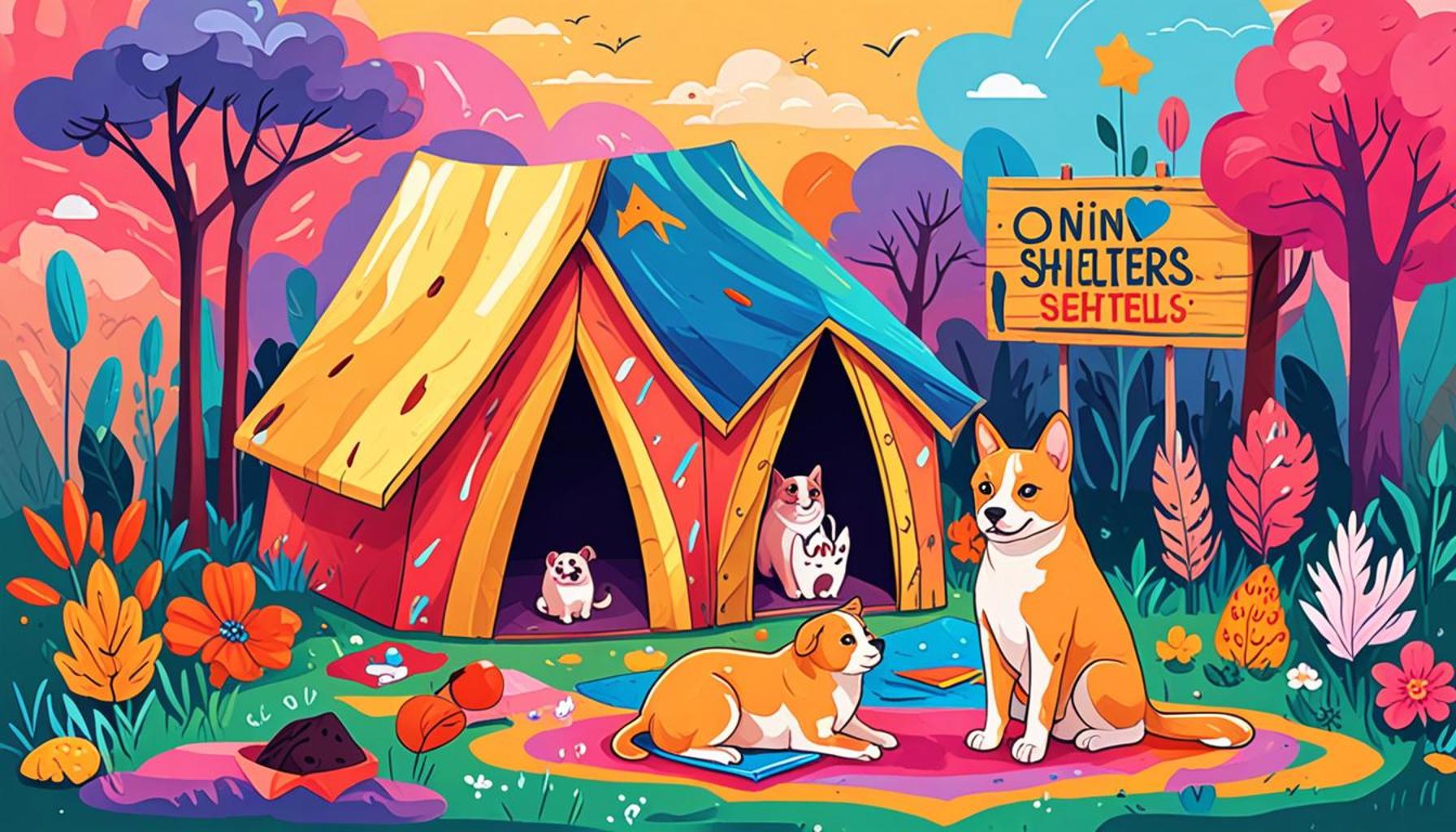The importance of transparency in adoptions: how shelters and organizations can improve communication about available pets.

The Importance of Communication in Pet Adoptions
In a world where countless animals reside in shelters, awaiting the warmth of a loving home, effective communication plays a pivotal role in the adoption process. It is not merely advantageous; it is imperative for fostering trust and ensuring that every pet finds a suitable match. When shelters and organizations communicate transparently, they facilitate informed decisions that benefit both the pets and potential adopters. Conversely, a lack of clarity can lead to misunderstandings, resulting in heartbreak for both the animals and the families looking to adopt.
Key Components of Effective Communication
- Detailed Pet Profiles: Shelters need to provide in-depth information about each animal, which includes not only physical characteristics and breed but also crucial insights into their personality traits, health status, and behavioral history. For example, a shy dog might require a patient and gentle adopter, while an energetic puppy would thrive in an active home. Such nuanced details aid potential owners in making choices that align with their lifestyle and expectations.
- Regular Updates: Utilizing platforms such as social media, websites, and even community newsletters to showcase available pets is vital. Regular postings on Instagram or Facebook can spark community engagement and help foster a sense of connection among potential adopters. For instance, a catchy post featuring a playful cat with a video showcasing its antics can capture hearts and encourage shares, widening the reach for that pet’s potential homes.
- Feedback Mechanisms: Encouraging past adopters to share their experiences is invaluable. Providing opportunities for feedback not only helps organizations understand their strengths and weaknesses but also gives future adopters insights into the qualities of various pets. Testimonials can highlight success stories that may resonate with prospective families, making the adoption process feel more personal and trustworthy.
Creating a Supportive Environment
By implementing these strategies, shelters can foster an atmosphere that supports informed decision-making. Transparency in pet adoption does not merely increase the rates of successful adoptions; it also reduces the chances of pets being returned to shelters, a fate that often leads to stress and anxiety for animals. When organizations emphasize effective communication and clarity, they help establish lasting relationships between pets and their new families, ensuring that both the pet and the adopters have a fulfilling experience.
Furthermore, as we delve deeper into the nuance of adoption processes, it is essential to explore additional practical strategies that shelters can implement. By doing so, they can continuously improve their communication methods and stay ahead of the evolving needs of the community. Engaging with local communities, collaborating with other animal welfare organizations, and keeping abreast of best practices will empower shelters to become more effective at placing animals in loving homes.
Conclusion
In conclusion, as the demand for pet adoption continues to grow, the importance of streamlined and effective communication becomes ever more critical. The future of animal welfare and the success of shelters hinge on their ability to connect with potential adopters authentically and transparently, paving the way for happy beginnings for both pets and their new families.
DISCOVER MORE: Click here to learn about balanced nutrition for your pet’s health
Enhancing Pet Adoption Processes Through Clarity
In the intricate world of pet adoption, transparency serves as the bedrock of successful placements. A clear line of communication not only informs potential adopters but also builds a foundation of trust that is essential in the delicate journey of bringing a new pet into a home. When shelters offer unambiguous details regarding each animal, it paves the way for more thoughtful decisions that reflect the needs of both the pet and the family. This process can undeniably influence the long-term outcomes of adoptions, ensuring that the right match is made.
Why Transparency Matters in Adoption
The need for transparency in adoptions goes beyond mere information sharing; it is a fundamental aspect that can significantly impact the well-being of the animals. Without clear communication, misunderstandings can arise, potentially resulting in animals being returned to shelters. Research has shown that the more informed an adopter is about a pet’s quirks and requirements, the less likely they are to experience difficulties post-adoption. Addressing this need for clarity, shelters can proactively implement several practical initiatives:
- Adoption Counseling: Providing potential adopters with counseling sessions can enhance understanding of an animal’s specific needs. These sessions can include discussions on pet behavior, care requirements, and what constitutes a lifestyle match.
- Pet History Documentation: Transparency regarding a pet’s history can be crucial. Shelters should aim to disclose any past trauma, behavioral challenges, or health concerns so that adopters are fully prepared for the transition.
- Open Shelter Policies: Encouraging visits to the shelter can foster a deeper connection. Allowing potential adopters to interact with pets in a supervised setting can facilitate informed decisions. Such practices can help assess compatibility between family dynamics and a pet’s temperament.
Strategies for Improved Communication
Implementing robust communication strategies can transform how shelters engage with the community and prospective adopters. Utilizing modern technology, such as dedicated websites and mobile applications, can streamline the process of sharing information. For instance, interactive platforms where families can filter available pets by size, age, temperament, and special needs can enhance user experience. Furthermore, engaging storytelling through videos and photographs can enable shelters to present an engaging narrative about each pet, highlighting their unique charm and personality.
As we look ahead, it is crucial for shelters to adapt and innovate their communication methods. This evolution can empower them to meet the demands of the public while ensuring that animals are placed in loving homes tailored to their specific requirements. The journey towards fostering transparency and effective communication in the adoption process ultimately benefits not only the pets awaiting homes but also the families eager to welcome a new member into their lives.
In exploring the importance of transparency in adoptions, it becomes evident that enhanced communication plays a crucial role in bridging the gap between shelters and potential adopters. Many individuals seeking to adopt pets often find themselves reliant on second-hand information or outdated listings. To combat this, shelters are encouraged to implement real-time updates on their websites and social media platforms, showcasing the availability of pets, their personalities, and their backgrounds. Such improvements not only allow interested adopters to make informed decisions but also build trust in the shelter’s processes.
Additionally, fostering a culture of honesty is essential. Organizations can achieve this by providing detailed descriptions of each pet, including any behavioral concerns or medical histories. Transparency in this context enhances the adopter’s understanding of the pet’s needs and potential challenges, leading to more successful placements. When adopters are well-informed, they are more likely to feel confident and committed to their adoption choice, ultimately reducing return rates and enhancing overall satisfaction.
Moreover, shelters can organize regular workshops and Q&A sessions for potential adopters. These events serve as platforms for open dialogue where individuals can ask questions about specific pets, the adoption process, and what to expect after bringing a pet home. By creating an environment of open communication, shelters not only empower potential adopters but also promote a community that supports responsible pet ownership.
| Category | Advantages |
|---|---|
| Informed Decisions | Potential adopters gain detailed insights into pet behavior and needs, leading to better matches. |
| Building Trust | Transparent communication fosters trust in shelters, enhancing community support and engagement. |
By implementing these strategies, shelters can significantly improve the adoption experience, ensuring that every pet finds a loving home while also empowering adopters with knowledge and confidence.
LEARN MORE: Click here to find out how early socialization can help
Building Relationships Through Open Dialogue
At the heart of successful pet adoptions is the relationship forged between shelters, organizations, and the communities they serve. Effective communication allows shelters not only to convey information but to also engage potential adopters in meaningful dialogue about their expectations and experiences. Establishing such a rapport can create a culture of caring and commitment toward responsible pet ownership, essential in reducing the number of animals returned to shelters.
Empowering Adopters with Knowledge
Educating potential adopters is another crucial facet of transparency in adoptions. Shelters can host informational workshops that cover a range of topics, including basic pet care, understanding pet behavior, and the responsibilities of pet ownership. Such initiatives can demystify the adoption process while providing valuable insights on how to nurture and integrate a new pet into their lives. For instance, workshops could focus on specific breeds, helping adopters to understand breed characteristics that may influence a successful adoption.
Moreover, shelters can utilize social media platforms to share knowledge in real-time. Regular posts featuring tips on animal care, success stories from previous adopters, and behind-the-scenes looks at shelter operations can help build a community of informed and engaged potential adopters. Programs like “Meet the Pet of the Week” can further humanize the adoption process by allowing followers to see an adoptable pet in action, ultimately showcasing their personality and needs.
Creating Comprehensive Profiles
A significant step toward transparency is the creation of comprehensive pet profiles that go beyond basic information like age, breed, and size. Profiles should include vital details about behavior, health history, and social interactions. For example, a pet that has been previously fostered may have insights to share about their likes, dislikes, and habits, offering potential adopters a clearer picture of what to expect. Incorporating this level of detail can vastly improve adoption success rates since families will be better prepared to meet the needs of their new companion.
- Behavioral Assessments: Conducting and documenting behavioral assessments prior to adoption can identify traits such as anxiety, friendliness, or shyness. These assessments should be shared openly to give adopters a realistic perspective of what can be expected.
- Medical Records Accessibility: Providing accessible medical information including vaccination history, spay/neuter status, and any ongoing health concerns assures adopters of the pet’s health and care. This transparency reduces the likelihood of unforeseen surprises post-adoption.
- Follow-Up Communication: Establishing a follow-up system post-adoption can aid adopters in seeking advice and support. Maintaining open lines of communication encourages a lifecycle relationship where adopters feel comfortable asking questions or expressing concerns.
In the evolving landscape of pet adoption, shelters and organizations must embrace innovative communication strategies to ensure transparency. By enhancing the clarity and richness of information available, they can better equip the community to make informed adoption choices. This approach not only enhances the experience for prospective pet owners but increases the likelihood of successful, lifelong bonds between pets and their families. In the end, every step taken towards transparency leads us closer to a shared goal: creating loving, sustainable homes for animals in need.
DISCOVER MORE: Click here for essential tips
Conclusion: Towards a Transparent Adoption Future
In summary, the importance of transparency in adoptions cannot be overstated. By fostering open communication between shelters, organizations, and potential adopters, we pave the way for informed decisions that ultimately lead to happier, more sustainable pet ownership experiences. When shelters prioritize comprehensive profiles, behavioral assessments, and accessible medical records, they create a transparent environment that encourages responsible adoption practices.
Moreover, educational initiatives such as workshops and the use of social media can bridge the gap between adopters and their future pets, transforming the adoption journey into a collaborative and enriching experience. As communities become better equipped with knowledge and clear expectations, the distinctions between adoption and ownership diminish. Clear communication not only builds trust but also cultivates lifelong relationships between pets and their families, significantly reducing the return rates of adopted animals.
As we look toward the future, it is imperative for shelters and organizations to continuously embrace innovative communication strategies and advocate for transparency. By doing so, they not only enhance their operations but also champion a culture of compassion and responsibility within the community. A transparent adoption process serves as a foundation for happier homes, ultimately ensuring that every pet has the chance to thrive in a loving environment. Let us strive for a future where every pet is matched with a family that fully understands and embraces their unique needs.


